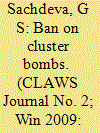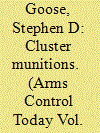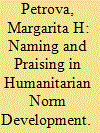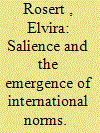| Srl | Item |
| 1 |
ID:
093996


|
|
|
| 2 |
ID:
080861


|
|
|
| 3 |
ID:
167981


|
|
|
|
|
| Summary/Abstract |
To examine the early development of humanitarian norm cascades, the author focuses on the processes that led to the adoption of the 1997 Mine Ban Treaty and the 2008 Convention on Cluster Munitions. Even though major military powers like the United States, Russia, and China opposed these initiatives, the latter set in motion quick norm cascades that brought about international legal norms stigmatizing land mines and cluster munitions. It is conventionally asserted that international norms emerge either due to great power backing or despite great power opposition, but the author argues that new norms can also take off because of great power opposition. When ngos and leading states actively foster normative change, a particular type of norm cascade is engineered—one generated by different mechanisms and starting earlier than postulated in the literature. Early norm cascading is driven not by emulation of peers and ngo naming and shaming of laggard states, but rather by leadership aspirations and naming and praising.
|
|
|
|
|
|
|
|
|
|
|
|
|
|
|
|
| 4 |
ID:
075754


|
|
|
| 5 |
ID:
089072


|
|
|
|
|
| Publication |
2009.
|
| Summary/Abstract |
By the end of 2008, ninety-five states had signed the Convention on Cluster Munitions, which bans the development, production, acquisition, stockpiling, and transfer of cluster munitions; imposes significant obligations for the clearance of unexploded cluster munition remnants; and elaborates novel requirements for so-called victim assistance. This article examines this agreement and the process that lead up to it in terms of the precedents it sets for future arguments about weapon technologies and the regulation of armed conflict. Particularly noteworthy was the process for determining what counts as a "cluster munition" under the convention. The definition structure transformed the argument from considerations of what types should be prohibited to demanding justifications for what should be allowed. In other words, rather than the burden of proof resting with those seeking a ban, the presumption became that exclusions from prohibition had to be argued in by proponents of specific submunition-based weapons. This approach contrasts with the manner in which the burden of proof regarding cluster munitions has been handled in international humanitarian law.
|
|
|
|
|
|
|
|
|
|
|
|
|
|
|
|
| 6 |
ID:
164437


|
|
|
|
|
| Summary/Abstract |
This article theorises salience – defined as the amount of attention granted to an issue – as an explanatory factor for the emergence and non-emergence of norms, and shows how salience affects existing explanations such as issue adoption by norm entrepreneurs, mobilisation, social pressure, and framing. The relevance of salience is demonstrated by exploring the question of why the norm against incendiary weapons was adopted in the Convention on Certain Conventional Weapons (CCW) in 1980, and why the norm against cluster munitions was not, even though both weapons were deemed particularly inhumane and thus, put on the agenda when the CCW negotiations started in 1978. Drawing on secondary sources and on original data from public and institutional discourses, I study the influence of salience on the emergence of the anti-napalm norm and the non-emergence of the anti-cluster munitions norm in the period of 1945–80. The results demonstrate that and how the discrepancy in salience of the napalm and the cluster munitions issues mattered for the outcomes of the two norm-setting processes.
|
|
|
|
|
|
|
|
|
|
|
|
|
|
|
|
| 7 |
ID:
093291


|
|
|
|
|
| Publication |
New York, United Nations, 2009.
|
| Description |
xxvii, 488p.
|
| Standard Number |
9789290451969
|
|
|
|
|
|
|
|
|
|
|
|
Copies: C:1/I:0,R:0,Q:0
Circulation
| Accession# | Call# | Current Location | Status | Policy | Location |
| 054637 | 341.37/UNI 054637 | Main | On Shelf | General | |
|
|
|
|